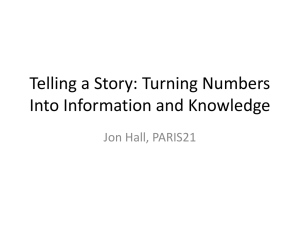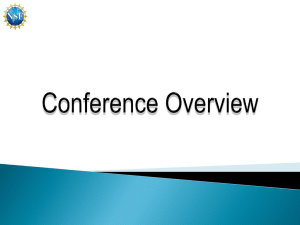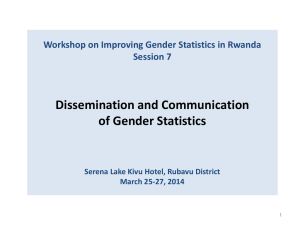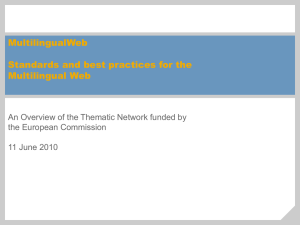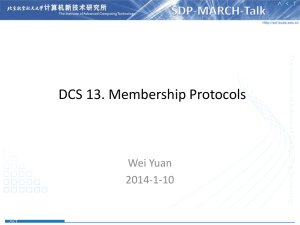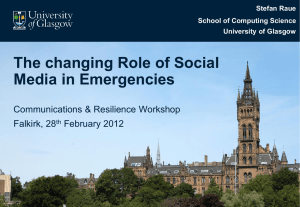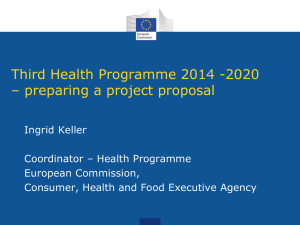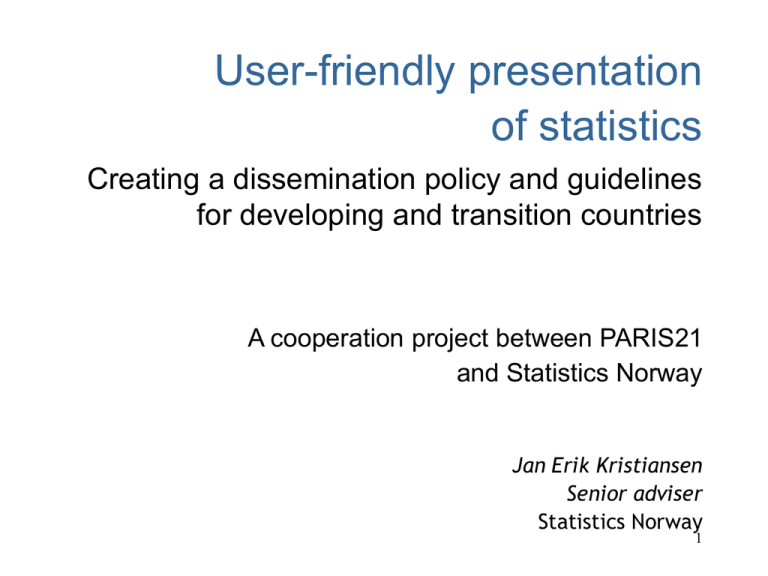
User-friendly presentation
of statistics
Creating a dissemination policy and guidelines
for developing and transition countries
A cooperation project between PARIS21
and Statistics Norway
Jan Erik Kristiansen
Senior adviser
Statistics Norway
1
”Publish or perish”!
2
In many NSOs dissemination is still
limited, because:
• Focus on data collection and processing
• Lack of experience (and coordination)
• ”Fear of dissemination”?
• Lack of dissemination strategy and guidelines
• But: Todays increase in the number of
studies, surveys and censuses could result
in a dramatic increase in dissemination:
3
5
112
5
7
9
744
5
7687 8 2 3477
7 9 112 8 347
779 6,3
8
135,4 9
56 2006=10
45 + 7 12%
7445
779 6,3
8
135,4 9
56 2006=10
45 + 7 12%
Tabulation
Methods/calculations
Statistics
Data entry & editing
Data
Data collection/surveys/adm. registers
(Master plan/strategy/MDGs/PRSPs, etc.)
NSOs = Numerical volcanoes?
4
User-friendly
presentation
Tabulation
Methods/calculations
Data entry & editing
Data collection/surveys/adm. registers
(Master plan/strategy/MDGs/PRSPs/etc.)
5
”The need to make outputs more user-friendly is also a useful concept and
should be further explored, particularly when the general level of discomfort
that the public displays about numerical data is taken into account”
From: ”The statistical infrastructure of the Caribbean countries”, 2005.
But what is “user-friendliness”?
Pentax IQZoom 200 QD 35mm Film Camera
An uncompromising yet user-friendly camera, the IQZoom 200
expands the realms of photographic possibility….
• Findable/easy to find
• Understandable/informative
– figures should be comparable and easy to compare
6
Examples of not so user-friendly
dissemination
Not primarily included to criticize, but to show
that improvement of dissemination is often a
question of minor changes
Our websites and publications are full of
tables and graphs that are ambiguous,
meaningless or even misleading.
Also: Examples are easier to understand and
remember than general rules and principles
7
“User-friendly”?
From: 2004 Census, Qatar
8
“User-friendly”?
16
14
12
10
8
6
4
Crude birth rate
2
Crude death rate
Natural increase
0
1995
1996
1997
1998
1999
2000
2001
2002
2003
From: Annual Statistical Digest 2006, Trinidad and Tobago
9
2004
“User-friendly”?
From: CSME Profile 2005-2006: A selection of various statistical indicators
Area Name
Antigua and Barbuda
Barbados
Belize
Dominica
Grenada
Guyana
Jamaica
Montserrat
Saint Kitts and Nevis
Saint Lucia
St. Vincent and The Grenadines
Suriname
The Bahamas
Trinidad and Tobago
Visitor Expenditure
Visitor Arrivals (000)
US Million Dollars
2005
2006
2005
2006
712
548
237
381
98
117
2,616
10
128
719
165
160
4,593
527
725
563
247
474
347
113
2,994
11
343
669
307
35
4,568
296
309.4
...
174.7
57.0
71.4
...
...
9.0
121.0
356.0
103.9
...
2,068.9
...
326.7
763.2
199.4
71.7
93.5
...
187.1
7.7
122.1
284.6
113.3
50.0
2,056.4
260.3
10
“User-friendly”?
Literacy rate. Adult men and women
Men
Women
1935
30.8
8.0
1945
44.3
13.5
1950
47.7
16.7
1955
56.3
21.3
1960
54.8
21.1
1965
64.7
27.6
:
:
etc.
From: Statistical Indicators 1923-2004, Turkstat
11
“User-friendly”?
From: www.caricomstats.org/
12
“User-friendly”?
Titles of graphs/tables:
Percentage distribution of households by type of household.
Better?: Household types. Per cent
Unemployed by sex and age
Better?: Unemployed men and women in different age groups
Pupil to teacher ratio
Better?: Pupils per teacher
13
“User-friendly”?
COPYRIGHT 2006-Ministry of Finance, International Financial Services and
Economic Affairs
All rights reserved. No part of this publication may be reproduced or transmitted
in any form or by anymeans, electronic or mechanical, including photocopy,
recording, or any information storage and retrieval system, without permission
in writing from the producer.
www.stlucia.gov.lc
Better:
”When using our statistics, please refer to Statistics Xxxxxx (name of
NSO) as the source”
14
General motto: KISS!
• Keep It Short and Simple!
• This applies to:
– Tables
– Graphs
– Titles
– Text
15
Contents of draft:
1. Dissemination: Formulating a strategy
2. Comparing numbers: Making the numbers talk
3. In columns and rows: Constructing tables
4. From table to graph: Why and how?
5. The media: Our best friends
6. The Internet: Something for everybody
7. In the shadow of the Internet: Printed publications
8. “This is how we do it”: Making dissemination guidelines
Read more? Some suggestions
Appendix I:
This is Norway – What the figures say: An example of a user-friendly publication
Appendix II:
Training for user-friendly dissemination: Some possible topics
16
Target group(s)?
• Chief statisticians/management
• Employees in disseminations units
• Others involved in dissemination
17
Dissemination
– some strategic issues
•
•
•
•
•
•
The role of users
The role of media
Printed publications – electronic dissemination?
Tables or analysis?
Dissemination: Centralized or decentralized?
Pricing policy
18
Users
• The most “important” users?
• “Serving the government”?
19
The role of users?
“User-friendly = “let’s ask the users”?
But many users do not know what they want!
And: We also want to attract new users!
So….
20
The role of the media
Traditional dissemination model
Media
The public
Libraries
NSI
Education
Government/org.
Business
21
“New” dissemination model
Media
The
public
Libraries
NSI
Education
Government/org.
Business
22
The media are of vital importance
because:
• They represent an important channel of
dissemination
• They help increase the visibility and public
recognition of the NSO
– and thereby improving the publics trust in statistics
23
Statistician and journalist:
Like cat and dog?
24
But: We must cooperate!
Journalists are our best
friends
25
An example of
“change in attitudes”?
26
Two basic rules when communicating
with the media:
• Equal treatment
– No pre-release access
• Establish a release calendar
27
Printed or electronic?
• Yesterday: Printed publication first, then electronic/
Internet
• Today: Parallel publishing: Paper and Internet
simultaneously
• Tomorrow: First on the Internet, then printed version.
(In Statistics Norway, an "Internet first"-policy has been
implemented. Statistics are since June 1999 released
daily on the Internet.).
28
Tables or analysis?
Numbers to the experts?
Analysis/comments to the media & the public?
But …
29
More “analysis”, because…
•
In a complex society, readers need to be
guided through the numerical jungel: “What
does the numbers really mean”?
•
The informed users and the general public
need explanations, interpretations and
comments
30
Why “analysis”?
•
“Analysis” forces us to look closer at the data:
concepts, definitions, measurements,
sampling, etc.
•
… and provides a necessary feedback into the
statistical production process, increasing the
quality of statistics, by uncovering errors and
mistakes in the statistics
31
Analysis is …
• To select among all the possible numbers
What is…
– Important?
– Interesting?
– New…?
• To make the figures comparable
• And to compare: point out differences, trends and
tendencies
– Over time/time series
– Between groups
– Or both
32
The future?
Publishing statistics: Two main directions?
Electronic
Numbers/
Tables
Text/
Analysis
Paper
1
(x)
(x)
2
1. Numbers/tables: On Internet
2. Text/analysis: Printed publications
33
A few words about the Internet:
• The responsibility for the web service should not
be left to the IT unit
• Something for everybody
• Tables and publications should be
downloadable
34
Internet (continued):
• Give priority to statistics
– instead of words of welcome, statements of missions
and visions, organizational charts or photos of the
chief statistician
35
Internet (continued):
• Keep it simple!
From: Central Agency for Mobilization and Statistics. Egypt
36
Internet (continued):
• Update as often as possible
• One suggestion: “Portion out” results from large
surveys and censuses
37
Dissemination: Centralized or decentralized?
A centralized dissemination unit should…
• contribute to a long-term dissemination strategy
• publish and inform about statistical results
• establish and maintain good relations with the media
• give advice in information and dissemination matters
• organize the production line and co-ordinate the different
aspects of production (tools/programs)
• make guidelines for design and layout for publications,
tables and charts and see that these rules are being
38
followed
A centralized dissemination unit should…
• develop knowledge about the various aspects of publishing;
including design, layout and the making of tables and charts
• initiate, edit and/or co-ordinate publications and presentations
involving various subject matter departments, like yearbooks
• have the overall editorial responsibility for the web service
• co-ordinate printed and electronic dissemination
• take care of distribution, subscriptions, marketing, contact with
users, etc.
39
Pricing policy
With Internet and a growing understanding of statistics as a
public good, the context of the pricing policy is changing:
- Today, charging for Internet-services is almost “impossible”
- Printed publications: Marginal costs
40
To increase user-friendly dissemination…
• Every NSO should develop a dissemination strategy – to make
the organization concious of the importance of dissemination
• Strategy = plans for the day after tomorrow = road map
• But more important is the will (and ability) to implement and
carry out the plans: Action speaks louder than words”
• Dissemination policy = dissemination guide(lines): ”This is how
we do it”
41
From strategy to guidelines: A schematic example
Long term strategic
goal
More userfriendly
presentation of
statistics
Policy/plans
Developing
the
Website
Actions/projects
Guidelines/
More and
better
metadata
Make tables
downloadable
in Excel
Guidelines
for metadata
Better media
relations
Better news
releases
Guidelines
for tables on
Internet
More and
better
analyses
Etc.
Etc.
Guidelines
for news
releases
42
The drafted guide does not propose any specific
strategies, policies or guidelines for the various aspects of
dissemination - these must be decided by the NSOs themselves,
depending on their present situation, available resources and ambitions
43
”This is how we do it”
Possible content of guidelines:
• News realeases and media relations
• Publication series
• The internet
• Tables
• Graphs
• Metadata
But remember:
KISS
44

